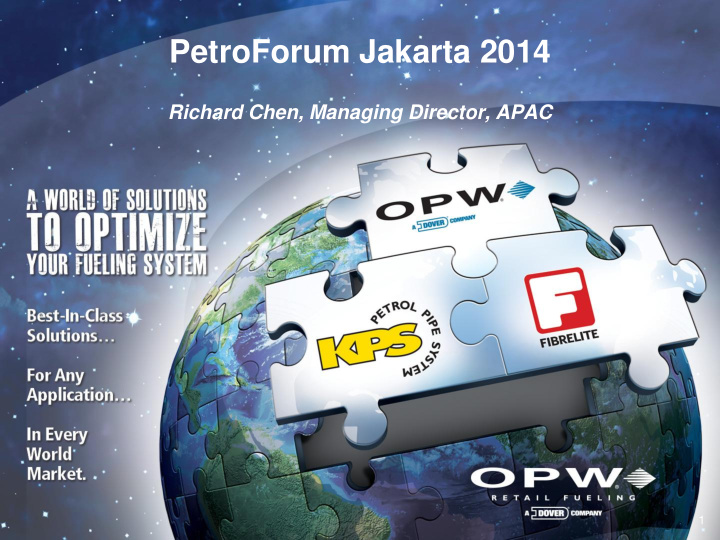



PetroForum Jakarta 2014 Richard Chen, Managing Director, APAC 1 1
2
OPW TOTAL VAPOUR SOLUTION ™ The World’s Most Innovative And Effective Vapour Solution Stops Excess Vapour Emissions To Protect The Environment Provides For Cleaner Air Saves Fueling Operators Money By Preventing Vapour Loss Improves Profitability By Converting Vapour To Saleable Fuel Provides Fast Payback (ROI) 3
OPW TOTAL VAPOUR SOLUTION ™ Controls The Creation Of Vapour Over The Duration Of The Delivery And Within The Storage Tanks On A Continuous Basis Keeps The Product In A Liquid State During The Delivery To Prevent An Increase Of Vapour Creation (Where The Largest Losses Occur) Manages The Vapour Collected From Nozzles On Stage 2 Systems 4
OPW TOTAL VAPOUR SOLUTION ™ Tankers Are Designed To Draw The Vapour Back From The Site Using The Vacuum Created By The Off-Loading Procedure This Is Done When Off- Loading Both Spirit & Diesel And Controlled At 32mbar 5
OPW TOTAL VAPOUR SOLUTION ™ There Are Four (4) Main Components Each Component Is An Integral Part In The Total Processing Of Stage 1B And Stage 2 Vapour And Vapour Produced By Natural Venting 6
OPW TOTAL VAPOUR SOLUTION ™ 1 Membrane Processing Unit 1 Converts Vapour Back Into Liquid-Returns Liquid Back To Underground Tank As Saleable Fuel Maintains Tank Pressure To Eliminate Vapour Emissions 7
OPW TOTAL VAPOUR SOLUTION ™ 2 Softfill System Device Reduces Vapour Pressures In Tanks By Spreading Delivery Across The Floor Of The Tank 2 Keeps The Surface And Product Calm During Deliveries To Eliminate Vapour Generation 8
OPW TOTAL VAPOUR SOLUTION ™ Accumulus Valve 3 Self Generating . No Power Required. 3 Offsets The Vacuum Created By Tanker Introduces The Vapour Back Into The Liquid Flow During Delivery (Wetting The Vapours) 9
OPW TOTAL VAPOUR SOLUTION ™ 4 Vapour Management Panel 4 Prevents Vapours From Returning To Tanker Retains Vapour In UST So It Can Be Processed Back Into Liquid Click to View Animation 10
PERFORMANCE 11
OPW TOTAL VAPOUR SOLUTION ™ Remember This Benefit: Historical Results For Wet Stock Losses For A Standard Site Have Shown That Expected Losses Could Be Between 0.25 To 0.35% Of Sales Volume. For Example, For A Site Selling 16,000,000 Liters Of Spirit And Taking An Average Loss Of 0.30% This Would Equate To: 16,000,000 x 0.30/100= 48,000 Liters Per Year!! • Using Data From A Test Site Which Has Been Operating For Over 6 Months The Results Have Shown A Reduction In Wet Stock Management Company. • Therefore A Site Selling 16,000,000 Million Liters Of Spirit Would Show A Loss Of 16,000,000 x 0.045/100= 7,200 Liters Per Annum. This Would Show An Average Annual Saving In The Region Of 40,800 Liters!!! 12
Electrostatic Hazards Of Plastic Pipework For Service Stations 13
Maddington Service Station, Perth, Western Australia 14
Flammable vapors • At the filling station there will always be a risk of a flammable atmosphere • ALL ignition sources must be eliminated 15
16
Static electricity generation in pipe Fuel flow creates charge separation in the pipe The charges cannot go anywhere (non- conductive materials cannot be earthed) and accumulate 17
Electrostatic induction Static charges create an electrostatic field Conductors within the field get an induced charge 18
Possible discharges Between areas on the Between negatively pipe wall with different charged pipe and charges. positively charged fuel. Between negatively charged pipe and grounded conductor. 19
Discharge In Chamber 20
Factors that influence the rate of static fires • Use of non-conductive fuel piping system • High speed fuel flow • Low conductivity fuels • Fuel quality, impurities in the fuel • Dry air • Turbulence: Elbows, reducers, filters or flame arresters • Vapor traps (underground fill boxes, chambers) 21
Standards documents Avoid non-conductive fuel piping system ( End to End continuity ) All major recommendations for hazardous areas strongly discourage the use of non grounded systems: Cenelec TR 50404 IEC TR60079-32 NFPA 30, 30A and 77 IP Guidelines Part 21 EN 14125, EN 13463-1 AS NZS 1020-1995 National Standards 22
If non-conductive fuel piping system is used.. If you decide to use non-conductive fuel piping system despite the risks, follow the the IEC standard TR60079-32 and/or EN14125 / EN13463-1: Take necessary precuations Unburied pipes are charged more so burial of the pipe is crucial Backfill on top of the pipes before starting any fuel flow Keep pipe lengths inside chambers as short as possible 23
Limit speed of fuel flow Charging increases with flow velocity Fuel flow must be maximum 2,8 m/s Max 2,8 m/s 24
Bonding and grounding All isolated conductive objects, such as flanges, jubilee clips, in chambers and fill boxes must be bonded and grounded 25
Summary of precautions* for non-conductive system Limit fuel flow to max 2,8 m/s Do not use flame arresters or filters until after careful consideration Mount safety vales on all fill necks Bond and ground all isolated conductive objects in chambers and fill boxes Cap welding socket wiring Check earthing arrangements after all work in chambers and fill boxes Check earthing arrangements periodically 1 time/year The list of precautions can be found in the standards mentioned. *The precautions cannot guarantee that no fire will occur 26
Nozzle with no continuity (Isolated) 27
Fire at the filling station must be prevented 28
Recommend
More recommend